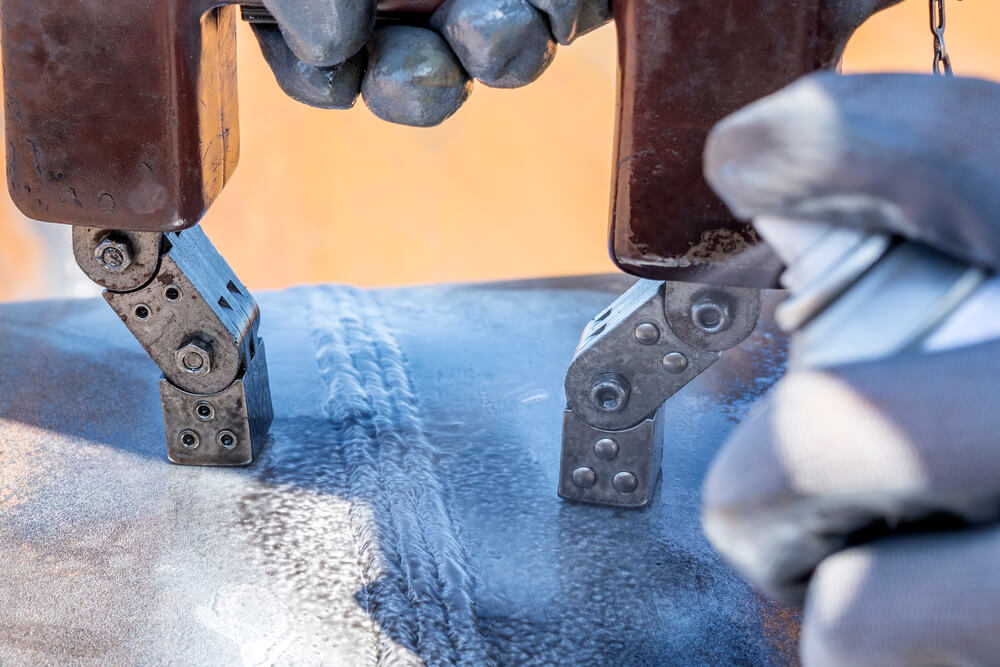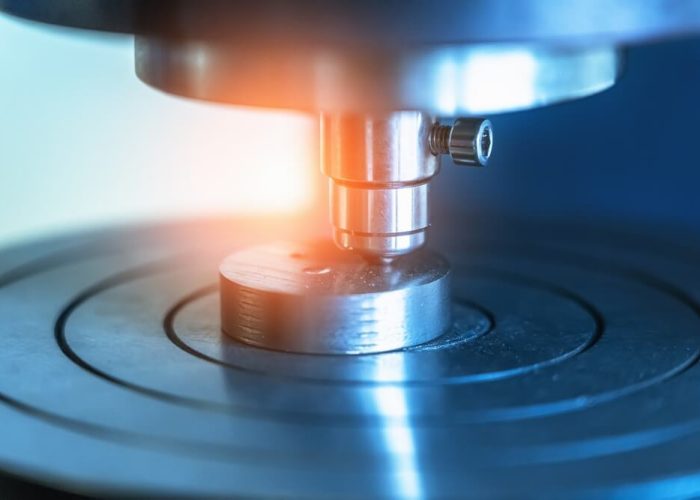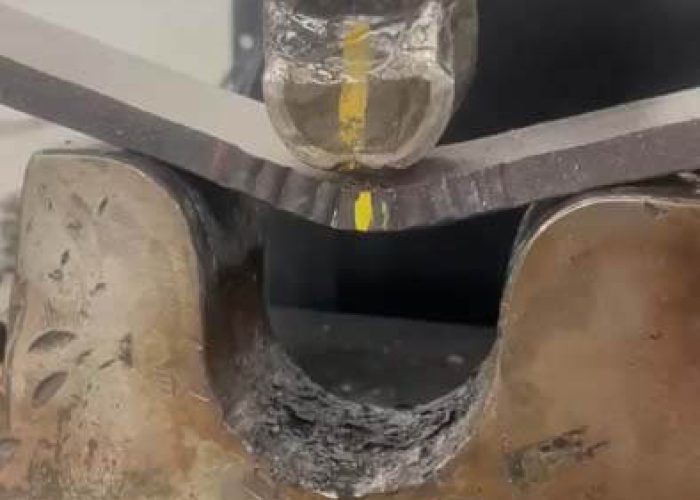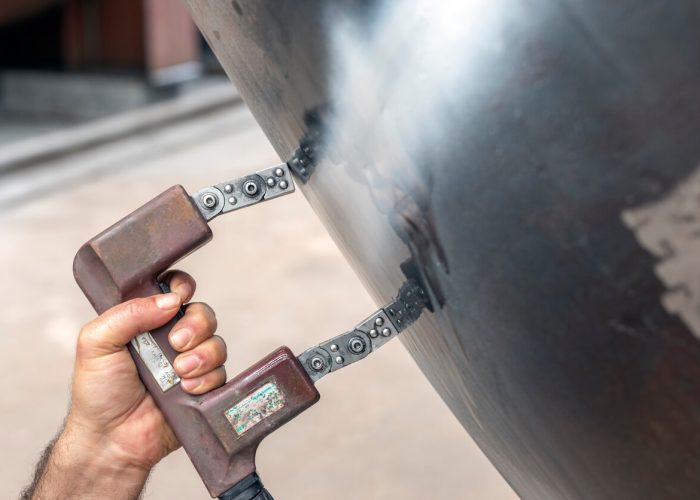Wet vs. Dry Magnetic Particle Testing: What’s the Difference
When we’re inspecting critical components for surface-breaking discontinuities, the choice between wet and dry magnetic particle testing methods can substantially impact detection results. We’re faced with a fundamental trade-off: wet methods offer superior sensitivity for fine defects but require more elaborate setup, while dry techniques provide simplicity and cost advantages with reduced detection capabilities. This decision goes beyond mere preference—it’s determined by industry standards, component criticality, and inspection conditions that we must carefully evaluate.

Key Points
- Wet MPT has superior sensitivity, detecting defects as small as 30 microns, while dry methods identify discontinuities of 100+ microns.
- Dry MPT is better for coarse surface-breaking defects, while wet methods excel at detecting fine subsurface flaws up to 6mm deep.
- Wet methods require more expensive equipment and maintenance, while dry methods offer lower initial costs but higher labor expenses.
- Dry powder testing struggles in high humidity environments, whereas wet methods are more sensitive to temperature fluctuations.
- Aerospace and oil industries typically require wet MPT’s higher sensitivity, while automotive applications often use dry methods for high-volume testing.
The Science Behind Magnetic Particle Testing
Although magnetic particle testing (MPT) relies on relatively simple magnetic principles, its application enables powerful nondestructive evaluation capabilities. When we magnetize a ferromagnetic material, magnetic flux lines travel through it. If a discontinuity exists, these flux lines are interrupted, creating what we call “flux leakage” at the defect site.
We leverage this phenomenon by applying magnetic particles (either dry or suspended in liquid) to the test surface. These particles, which are themselves magnetic, are attracted to areas of flux leakage, forming visible indications that reveal otherwise hidden defects.
This process works because discontinuities perpendicular to the magnetic field create the strongest flux leakage. That’s why we’ll often apply magnetization in multiple directions to guarantee we catch defects regardless of their orientation in the test specimen.
Both wet and dry techniques can be enhanced using fluorescent particles that improve detection sensitivity under ultraviolet light.
Principles of Wet Magnetic Particle Testing
Wet magnetic particle testing represents a specialized variation of MPT where ferromagnetic particles are suspended in a liquid carrier fluid, typically water or oil with appropriate conditioning agents.
Ferromagnetic particles suspended in liquid carriers enable superior detection sensitivity in specialized MPT applications.
We apply this suspension to the test surface either by flooding or spraying while the component is magnetized.
The liquid medium enables particles to move freely across the surface, allowing them to migrate toward and accumulate at flux leakage fields.
This method offers several advantages: enhanced particle mobility, superior surface coverage, and improved sensitivity for detecting subsurface defects.
We’ll typically use fluorescent particles in wet MPT, which glow under ultraviolet light, further enhancing detection capabilities.
The inspection sensitivity can be controlled through particle concentration, magnetization technique, and application method—making wet MPT ideal for critical components requiring high detection reliability.
The selection of wet MPT over other methods should be guided by careful consideration of material properties and the specific defect types you’re looking to identify.
Principles of Dry Magnetic Particle Testing
In dry magnetic particle testing, we apply ferromagnetic powder directly to the part’s surface using several methods including dusting, immersion, and spray application.
We’ll examine how these application techniques influence the powder’s ability to adhere to flux leakage fields at surface discontinuities.
Dry powder testing excels at detecting surface-breaking defects and can identify subsurface flaws up to 0.25 inches deep under ideal conditions.
This method is particularly effective for ferromagnetic materials and requires proper certification from organizations like AWS and ASNT to ensure accurate interpretation of results.
Powder Application Methods
Dry magnetic particle testing employs several distinct powder application methods, each designed to maximize defect detection in different inspection scenarios.
We typically use powder bulbs, powder guns, or fluidized beds for controlled distribution across the test surface.
Powder bulbs offer simple, targeted application for small areas and are ideal for field inspections.
Powder guns provide more consistent coverage for larger components, with adjustable flow rates allowing us to tailor application density.
For high-volume inspections, fluidized beds suspend particles in an air stream, ensuring uniform coating across complex geometries.
When we’re testing overhead or vertical surfaces, we’ll generally select coarser powders that adhere better against gravity.
Regardless of method, we must apply powder while magnetization is active to achieve ideal particle mobility and accurate defect indication.
Defect Detection Capabilities
Magnetic particle testing excels at revealing surface and near-surface discontinuities that would otherwise remain invisible to the naked eye. Dry magnetic particle methods particularly shine when detecting coarse discontinuities such as cracks, seams, and fatigue failures.
We’ve found dry powder most effective for locating surface-breaking defects with widths typically larger than 10μm. The particle accumulation at defect sites creates visible indications with high contrast, especially when using fluorescent particles under UV illumination.
However, dry methods have limitations with very fine cracks and subsurface flaws deeper than 3mm.
For ideal detection, we must consider the specimen’s surface condition, as roughness can mask indications or create false positives.
We’re consistently achieving best results on smooth, clean surfaces where powder mobility isn’t impeded.
Comparative Sensitivity and Detection Capabilities
We’ll now examine the comparative sensitivity of magnetic particle testing by evaluating detection thresholds across different inspection scenarios.
The orientation of defects relative to magnetic field lines substantially impacts detection capability, with ideal results occurring when discontinuities are perpendicular to the field.
While magnetic particle testing excels at locating surface defects, its effectiveness diminishes with subsurface flaws, where detection depth is typically limited to approximately 0.25 inches below the surface.
Unlike more penetrating methods like ultrasonic testing (UT), magnetic particle testing is specifically designed for use with ferromagnetic materials only.
H1. Detection Threshold Comparison
When evaluating magnetic particle testing methods, understanding detection thresholds represents a critical performance metric that directly impacts inspection reliability. Wet method testing consistently demonstrates superior sensitivity, detecting defects as small as 30 microns in ideal conditions, while dry methods typically identify discontinuities of 100 microns or larger.
We’ve found that wet fluorescent techniques offer the lowest detection thresholds, particularly for fine subsurface flaws. In contrast, dry methods excel in detecting larger surface-breaking defects but struggle with shallow or tight discontinuities.
The visibility enhancement from suspension media in wet methods enables us to reliably detect 50-70% smaller defects than comparable dry applications. This significant threshold difference must inform our method selection when critical components require thorough examination of potentially microscopic structural compromises.
H2. Defect Orientation Effects
Despite advancements in magnetic particle testing technology, defect orientation relative to magnetic flux lines remains a fundamental determinant of detection capability.
We’ve consistently observed that defects perpendicular to magnetic flux lines produce the strongest indications, while parallel defects often escape detection entirely.
Wet method testing provides superior detection of defects regardless of orientation, especially when using fluorescent particles that enhance visibility of even slightly misaligned discontinuities.
The fluid carrier improves particle mobility, allowing them to settle into defects at various angles.
Dry method testing shows more significant sensitivity drop-off with non-perpendicular defects.
To compensate, we often perform multi-directional magnetization when using dry particles, applying fields in two or more directions to guarantee thorough inspection.
This approach is particularly vital when examining components with complex geometries or unknown defect orientations.
H3. Surface vs. Subsurface Detection
Magnetic particle testing (MPT) demonstrates substantially higher sensitivity for surface-breaking defects compared to subsurface discontinuities, with detection capability diminishing rapidly as defect depth increases.
We typically observe ideal detection for surface cracks, while subsurface flaws beyond 3-6 mm generally remain undetected regardless of technique applied.
Wet MPT offers superior subsurface detection compared to dry methods.
The mobility of particles in suspension allows them to respond to weaker leakage fields emanating from deeper flaws.
We’ve found fluorescent wet techniques particularly effective, offering up to 2-3 times deeper penetration than standard dry methods.
When we’re inspecting components where subsurface defects are critical concerns, we’ll need to complement MPT with volumetric methods like ultrasonic or radiographic testing to guarantee thorough inspection coverage.
Environmental Considerations and Constraints
The environmental considerations and constraints in magnetic particle testing (MPT) substantially impact both testing efficacy and regulatory compliance.
We’ve found that temperature fluctuations can alter magnetic particle mobility, with wet methods being particularly sensitive to extreme conditions.
Temperature variations significantly impact wet method magnetic particle mobility, requiring careful environmental control for reliable inspection results.
Dry powder testing struggles in high humidity environments where particles may clump or adhere improperly to surfaces.
We must also consider waste management protocols, especially with wet methods.
Oil-based carriers require proper disposal to meet environmental regulations, while water-based solutions present fewer hazards but may introduce corrosion risks.
Additionally, ventilation becomes critical during dry powder application to prevent inhalation hazards for our technicians.
When selecting between wet and dry methods, we’ll need to evaluate workplace conditions, available containment systems, and local regulatory requirements to guarantee our MPT process remains both effective and compliant.
Working with WH Labs ensures that environmental testing factors are properly evaluated according to industry standards for consistent and reliable MPT results.
Equipment Requirements and Setup
Environmental factors inform not just our testing protocols but also our equipment selections for magnetic particle testing operations.
We’ll need different setups depending on whether we’re implementing wet or dry methods.
For dry testing, we require a particle applicator (typically a powder bulb or aerosol), yokes or prods for field generation, and proper lighting systems—typically UV lights that reach at least 1000 μW/cm².
Wet method setups demand circulation systems, suspension tanks, black light stations, and field strength measurement instruments.
We’ll also need specialized spray equipment for the suspension medium application.
Both methods require appropriate calibration standards, demagnetization equipment, and means to verify field strength.
Remember to establish sufficient electrical capacity and ventilation before installing the equipment.
Regardless of which method you choose, all equipment must comply with industry standards such as ASME, AWS, and ISO guidelines to ensure reliable defect detection and testing validity.
Industry-Specific Applications and Standards
While various industries utilize magnetic particle testing, each sector has developed specialized standards and procedures to address unique inspection challenges.
We’ve compiled key industry standards that govern MPT implementation across different fields:
- Aerospace (AS5282) – Requires higher sensitivity levels and often mandates fluorescent particles for critical components like turbine disks and landing gear
- Automotive (ASTM E1444) – Focuses on high-volume testing of drivetrain components with standardized acceptance criteria for various defect types
- Oil and Gas (ASME BPVC) – Emphasizes wet method testing for pipeline welds and pressure vessels operating in harsh environments
- Military (MIL-STD-1949) – Specifies rigorous documentation requirements and personnel qualification standards, often requiring both wet and dry methods
We’ll help you navigate these standards to guarantee your inspection protocols maintain compliance while maximizing defect detection. Similar to magnetic particle testing, ultrasonic testing techniques can be tailored for specific industry applications to detect internal flaws without causing damage to materials.
Cost Analysis and Operational Efficiency
Implementing magnetic particle testing effectively requires balancing initial equipment investments against long-term operational benefits. Wet method systems typically demand higher upfront costs ($15,000-$40,000) for specialized equipment, recirculation systems, and particle baths. However, they offer faster inspection rates and superior detection sensitivity, particularly for automated production environments.
Dry systems, costing $3,000-$10,000 initially, present a more economical entry point for facilities with limited testing needs. We’ve found they require less maintenance and consumable expenses but may incur higher labor costs due to slower inspection rates.
When calculating total cost of ownership, we must consider facility infrastructure requirements, technician training, waste disposal protocols, and regulatory compliance. The ideal choice ultimately depends on testing volume, defect detection requirements, and available facility resources. Both testing methods should adhere to ASTM standards to ensure consistent and reliable results across different testing laboratories.
Best Practices for Method Selection
Selecting the appropriate magnetic particle testing methodology requires thorough assessment of several critical parameters.
We need to evaluate the inspection environment, defect characteristics, part geometry, and operational constraints to optimize detection reliability.
When determining which method will yield superior results, we’ve found these factors most critical:
- Material composition and permeability values that affect magnetic field distribution
- Surface condition including roughness, coatings, and potential contaminants
- Defect orientation relative to the induced magnetic field path
- Production throughput requirements and facility limitations
We recommend conducting comparative tests on representative samples when uncertainty exists.
This practical approach prevents potential detection misses and guarantees we’re maximizing inspection effectiveness.
Remember that proper method selection ultimately serves as the foundation for dependable quality assurance protocols.
Our Non-Destructive Testing specialists can provide expert guidance on selecting the best method for your specific inspection needs.
Frequently Asked Questions
How Long Does Technician Certification for Magnetic Particle Testing Take?
We typically complete MT certification in 40-80 hours of training plus practical experience. Requirements include classroom instruction, hands-on practice, and passing examinations according to industry standards like SNT-TC-1A.
Can Magnetic Particle Testing Be Performed on Non-Ferromagnetic Materials?
No, we can’t perform magnetic particle testing on non-ferromagnetic materials. This NDT method relies on materials that respond to magnetic fields, like iron, nickel, and cobalt alloys.
What Safety Precautions Are Required When Handling Magnetic Particle Testing Materials?
We’ll need proper PPE including gloves and eyewear when handling magnetic particles. We must follow SDS guidelines, guarantee adequate ventilation, and avoid inhalation of dry particles or aerosols.
How Often Should Magnetic Particle Testing Equipment Be Calibrated?
We recommend calibrating MPT equipment annually at minimum, with additional verification checks before each use. ASTM E1444 and ASNT guidelines specify standards our industry follows for proper instrument performance.
Can Magnetic Particle Testing Detect Subsurface Defects in Welded Joints?
We can detect shallow subsurface defects in welded joints using magnetic particle testing, but its effectiveness diminishes rapidly with depth. For deeper defects, consider ultrasonic or radiographic methods instead.
Takeaway
We’ve established that method selection hinges on defect characteristics, equipment availability, and inspection criticality. Wet testing delivers superior sensitivity for fine discontinuities in critical components, while dry testing offers cost-efficiency for general inspections of large surfaces. Our implementation decisions must balance sensitivity requirements against operational constraints, always adhering to industry-specific standards that govern magnetic particle testing procedures.



